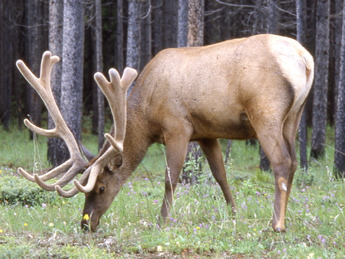|
| |
 |
| | |
#8 - The Elk (Wapiti)
|
| | |
The Elk, Cervus canadensis, or Wapiti as it is often called, is a regal, majestic, large member of the deer family.
It is found across western North American and eastern Asia. Together, there is a total of ten subspecies.
|
| | |
One of the most striking characteristics of the elk which distinguishes it from all other deer is the spectacular rack of antlers that the males shed and grow annually. Each year the antlers have more points - a sign of strength and age which helps attract females as well as deters rival bulls when it's rutting season.
Made of bone, the antlers grow rapidly and while developing they are covered with a protective "velvet" which is gradually rubbed off. The antlers can grow to about 5 ft (1.6 m) across and weigh some 40 lb (18 kg). |
|
| |
|
 |
|
Elk grow to 4-5 ft (3-4.5 m) tall with males weighing 700-1000 lb (315-450 kg) and females somewhat smaller at 500-600 lb (225-270 kg). They prefer forests, meadows and grassy areas in where they feed and graze on grasses, leaves, plants and bark. |
| |
|
 |
Most of the year, elk spend their time in same-sex groups, but in the fall the mating season begins. The mountains can be full of the magical sounds of the bugling males - a sort of curious scream that echoes through the valleys. Bugling attracts females and eventually a dominate male, after challenging, fighting and wrestling other males, will establish a harem consisting of about 20 cows or more. These he will defend from predators and other bulls. Unsuccessful bulls will generally spend the winter in groups together. |
|
| | |
|
|
|
| |
| Dereila Nature Inn Home > Woodlands Pathway > Mammals Wildzone > Walking in the Wild > The Elk (Wapiti) |
| | |
|
|
|
Home | All Things Natural Restaurant | Bird's Nest Lounge | Cyber Room | Lagoon Trail | Naturalist's Nook | Wildflower Garden | Woodlands Pathway
Site Map | Inbox | FAQs | News and Updates | Newsletter Information | Games Room | Privacy Policy
All content © Dereila and Sage Innovations
|







